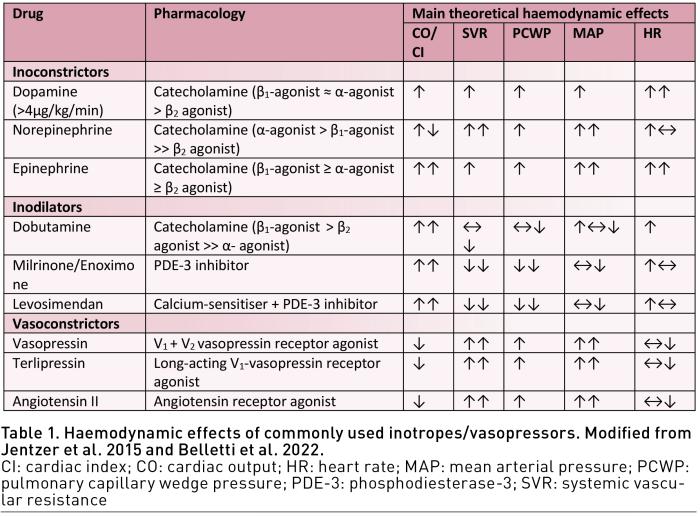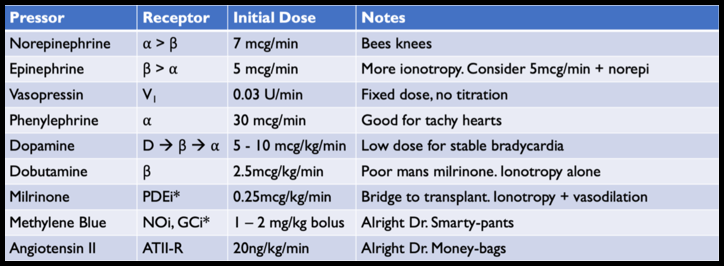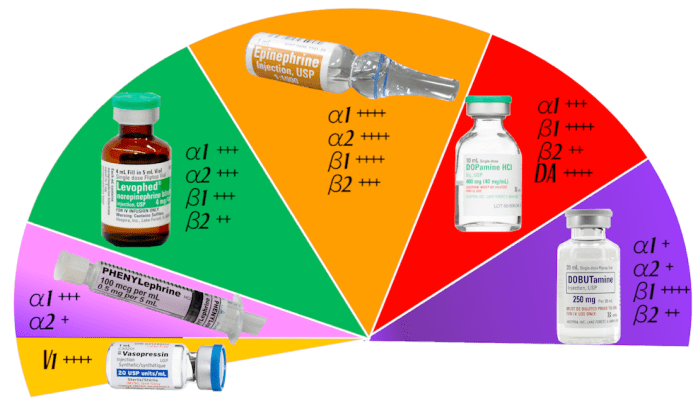Vasopressors, powerful medications that constrict blood vessels, play a critical role in managing life-threatening conditions. These drugs are often the lifeline for patients experiencing dangerously low blood pressure, a condition known as hypotension. From sepsis and trauma to cardiac arrest, vasopressors can be crucial in stabilizing a patient’s hemodynamics and improving their chances of survival.
Understanding the intricacies of vasopressors, including their mechanisms of action, clinical applications, and potential complications, is paramount for healthcare professionals. This exploration delves into the fascinating world of vasopressors, highlighting their essential role in modern medicine.
Vasopressor-Associated Complications

Vasopressors are powerful medications that can help to stabilize blood pressure in patients with severe hypotension. However, their use is associated with potential complications, which can range from mild to life-threatening. Understanding these complications and implementing strategies to minimize their occurrence is crucial for ensuring patient safety.
Tissue Ischemia
Tissue ischemia, or a lack of blood flow to tissues, is a significant concern associated with vasopressor therapy. Vasopressors, by constricting blood vessels, can restrict blood flow to vital organs, particularly in the presence of pre-existing vascular compromise. This can lead to organ dysfunction and even failure.
- Mechanism: Vasopressors, by increasing peripheral vascular resistance, can reduce blood flow to organs, particularly in areas with already compromised circulation. This can result in tissue hypoxia and potential necrosis.
- Minimizing Risk:
- Careful monitoring: Closely monitoring vital signs, including peripheral perfusion and organ function, is essential.
- Titration: Titrating the dose of vasopressors to achieve the desired hemodynamic effect while minimizing vasoconstriction is crucial.
- Adequate fluid resuscitation: Maintaining adequate fluid volume is essential to ensure sufficient blood flow to tissues.
Arrhythmias
Vasopressors can trigger cardiac arrhythmias, which can be potentially life-threatening. These arrhythmias can arise from direct effects on the heart, such as increased heart rate and contractility, or from indirect effects, such as electrolyte disturbances.
- Mechanism:
- Direct effects: Vasopressors can directly stimulate the heart, leading to increased heart rate and contractility, which can trigger arrhythmias.
- Indirect effects: Vasopressors can also induce electrolyte disturbances, particularly hypokalemia, which can further increase the risk of arrhythmias.
- Minimizing Risk:
- Electrolyte monitoring: Closely monitoring electrolytes, particularly potassium, is crucial to identify and correct any imbalances promptly.
- Cardiac monitoring: Continuous cardiac monitoring is essential to detect and manage any arrhythmias that may arise.
- Careful titration: Titrating the dose of vasopressors to achieve the desired hemodynamic effect while minimizing the risk of arrhythmias is essential.
Electrolyte Disturbances
Vasopressor therapy can contribute to electrolyte disturbances, particularly hypokalemia, which can worsen the risk of arrhythmias and other complications.
- Mechanism: Vasopressors can promote potassium shifts from the intracellular to the extracellular space, leading to hypokalemia. This can occur due to various mechanisms, including increased renal excretion of potassium and stimulation of the sodium-potassium pump.
- Minimizing Risk:
- Electrolyte monitoring: Regular monitoring of electrolytes, particularly potassium, is essential to identify and correct any imbalances promptly.
- Potassium supplementation: If hypokalemia develops, potassium supplementation may be necessary to restore normal levels.
Vasopressor Alternatives and Future Directions

The use of vasopressors remains a cornerstone of critical care medicine, particularly in managing hemodynamic instability. However, the inherent risks associated with their use necessitate a continuous exploration of alternative strategies and advancements in vasopressor therapy.
Non-Pharmacological Alternatives
Non-pharmacological approaches are gaining traction as potential alternatives to vasopressors, particularly in specific clinical scenarios. These strategies aim to address the underlying causes of hemodynamic instability rather than solely focusing on symptom management.
- Mechanical circulatory support: Devices such as extracorporeal membrane oxygenation (ECMO) and ventricular assist devices (VADs) can provide hemodynamic support in cases of severe heart failure or cardiogenic shock. These devices offload the heart, improving cardiac output and reducing the need for vasopressors.
- Fluid resuscitation: Adequately restoring circulating volume is crucial in managing hemodynamic instability. Judicious fluid administration can improve preload and cardiac output, potentially reducing the need for vasopressors. However, fluid overload can be detrimental, especially in patients with compromised cardiac function.
- Positional maneuvers: Simple maneuvers such as leg elevation or Trendelenburg positioning can enhance venous return and improve cardiac preload, potentially reducing the need for vasopressors in certain situations.
Emerging Vasopressor Therapies
Ongoing research is exploring novel vasopressor agents and therapeutic approaches to address the limitations of traditional vasopressors.
- Selective alpha-1 agonists: These agents target specific alpha-1 receptors, potentially offering a more selective vasoconstriction effect with fewer adverse effects compared to non-selective alpha agonists like norepinephrine. Examples include phenylephrine and methoxamine.
- Vasodilator-mediated vasopressor therapy: Combining vasodilators with vasopressors aims to optimize hemodynamics by addressing both vasoconstriction and vasodilation needs. This approach might be particularly beneficial in patients with septic shock, where both vasodilation and decreased myocardial contractility contribute to hemodynamic instability.
- Targeted therapies: Research is investigating novel agents that specifically target specific pathways involved in hemodynamic regulation. For example, agents targeting the renin-angiotensin-aldosterone system (RAAS) or endothelin receptors are being explored for their potential to improve hemodynamics in specific conditions.
Future Research Directions
Future research endeavors in vasopressor therapy aim to develop safer and more effective strategies to manage hemodynamic instability.
- Personalized vasopressor therapy: Tailoring vasopressor therapy based on individual patient characteristics and specific clinical scenarios is a key focus. This includes factors such as age, underlying disease, and specific hemodynamic parameters.
- Development of novel vasopressors: Research is actively exploring new vasopressor agents with improved selectivity, reduced side effects, and enhanced efficacy. This includes developing agents that target specific receptor subtypes or utilize novel mechanisms of action.
- Combination therapies: Combining vasopressors with other therapeutic agents, such as inotropes or vasodilators, is an area of ongoing investigation. This approach aims to optimize hemodynamic response and minimize adverse effects.
Vasopressor Use in Specific Patient Populations
Vasopressors are essential in managing hemodynamic instability, but their use in specific patient populations requires careful consideration due to unique physiological and pharmacological considerations. These patient groups often exhibit heightened sensitivity to vasopressor effects, making it crucial to tailor treatment strategies to minimize potential complications.
Pregnancy
Pregnancy presents a unique physiological landscape, with alterations in hemodynamics and drug metabolism. Vasopressor use during pregnancy requires careful assessment of maternal and fetal risks.
- Maternal Considerations: Vasopressors can impact maternal hemodynamics, potentially causing vasoconstriction and reduced uteroplacental blood flow, which can affect fetal oxygenation.
- Fetal Considerations: Vasopressors can cross the placenta and potentially affect fetal development.
- Drug Selection: Some vasopressors, such as phenylephrine, are considered safer in pregnancy than others, such as dopamine, due to their limited placental transfer and potential for fetal bradycardia.
- Dosage Adjustment: Pregnancy-related changes in hemodynamics and drug metabolism necessitate dose adjustments, often requiring lower doses than in non-pregnant patients.
- Monitoring: Continuous fetal monitoring is crucial to assess fetal well-being during vasopressor therapy.
Renal Failure
Patients with renal failure are particularly susceptible to the adverse effects of vasopressors, as these medications can exacerbate renal dysfunction.
- Reduced Renal Blood Flow: Vasoconstriction induced by vasopressors can further decrease renal blood flow, potentially leading to acute kidney injury.
- Drug Accumulation: Renal dysfunction can lead to the accumulation of vasopressors, increasing the risk of adverse effects.
- Drug Selection: Vasopressors with minimal renal excretion, such as norepinephrine, may be preferred in patients with renal failure.
- Dosage Adjustment: Lower doses and close monitoring are crucial to minimize the risk of renal complications.
Liver Disease
Patients with liver disease may exhibit altered drug metabolism and hemodynamics, requiring careful consideration when using vasopressors.
- Drug Metabolism: Liver disease can impair the metabolism of vasopressors, leading to prolonged drug action and increased risk of adverse effects.
- Hemodynamic Instability: Liver disease can result in hypovolemia and impaired vascular reactivity, making patients more susceptible to vasopressor-induced complications.
- Drug Selection: Vasopressors with minimal hepatic metabolism, such as norepinephrine, may be preferred in patients with liver disease.
- Dosage Adjustment: Lower doses and close monitoring are essential to manage hemodynamics and prevent complications.
Pediatric and Geriatric Populations, Vasopressor
Vasopressor use in pediatric and geriatric populations requires specialized considerations due to age-related differences in physiology and drug metabolism.
Pediatric Population
- Drug Metabolism: Children have a higher metabolic rate and a more rapid drug clearance than adults, requiring higher doses of vasopressors to achieve therapeutic effects.
- Cardiovascular System: The pediatric cardiovascular system is still developing, making children more susceptible to vasopressor-induced complications, such as tachycardia and arrhythmias.
- Dosage Adjustment: Accurate weight-based dosing is crucial to minimize the risk of adverse effects.
- Monitoring: Continuous hemodynamic monitoring is essential to assess the effectiveness and safety of vasopressor therapy.
Geriatric Population
- Drug Metabolism: Older adults have slower drug metabolism and clearance, requiring lower doses of vasopressors to avoid drug accumulation and adverse effects.
- Cardiovascular System: Age-related changes in cardiovascular function, such as decreased cardiac output and vascular stiffness, can make older adults more sensitive to vasopressor-induced complications.
- Dosage Adjustment: Lower doses and close monitoring are essential to manage hemodynamics and prevent complications.
- Co-morbidities: Older adults often have multiple co-morbidities, which can further complicate vasopressor therapy.
Vasopressor Research and Development

Vasopressor research is an active area of investigation, with ongoing efforts to optimize existing therapies and develop novel agents. Current research trends focus on understanding the mechanisms of action of vasopressors, identifying patient populations who may benefit most from specific agents, and developing strategies to minimize adverse effects.
Clinical Trials Investigating Vasopressor Use
Clinical trials are ongoing to evaluate the efficacy and safety of various vasopressors in different clinical settings.
- The Vasopressin in Septic Shock Trial (VASSAR) investigated the use of vasopressin in patients with septic shock and found that it improved hemodynamics but did not reduce mortality.
- The NEPHRITE trial evaluated the use of norepinephrine versus dopamine in patients with septic shock and found no significant difference in mortality or other outcomes.
- The REVERSE trial is evaluating the use of a combination of vasopressin and norepinephrine in patients with septic shock.
Optimizing Vasopressor Therapy
Researchers are investigating strategies to optimize vasopressor therapy, including:
- Developing personalized dosing regimens based on individual patient characteristics, such as age, weight, and underlying medical conditions.
- Exploring the use of vasopressors in combination with other therapies, such as fluids, antibiotics, and mechanical ventilation.
- Investigating the role of continuous monitoring of hemodynamic parameters to guide vasopressor therapy.
Developing Novel Vasopressors
Research is ongoing to develop novel vasopressors with improved efficacy, safety, and pharmacokinetic profiles.
- Researchers are investigating the potential of new vasopressors, such as angiotensin II and endothelin-1, which may have different mechanisms of action and potentially fewer side effects.
- Other research focuses on developing vasopressors that are more selective for specific receptors, which could lead to improved efficacy and reduced adverse effects.
Impact of Vasopressor Research
Ongoing research is expected to have a significant impact on the future of vasopressor use.
- The development of more effective and safer vasopressors could lead to improved outcomes for patients with critical illnesses.
- Personalized dosing regimens and continuous monitoring could help optimize vasopressor therapy and minimize adverse effects.
- New vasopressors with novel mechanisms of action could provide additional therapeutic options for patients who do not respond to current therapies.
Ethical Considerations in Vasopressor Use
Vasopressors are powerful medications that can be life-saving in critically ill patients, but their use also raises complex ethical considerations. These considerations become particularly pronounced in the context of end-of-life care and palliative medicine, where the balance between prolonging life and respecting patient autonomy and quality of life is paramount.
Ethical Frameworks and Guidelines
Ethical frameworks and guidelines provide a structure for navigating these challenging situations.
- Beneficence and Non-maleficence: The principles of beneficence (acting in the patient’s best interest) and non-maleficence (avoiding harm) are central to medical decision-making. Vasopressor use must be carefully weighed against the potential benefits and risks, considering the patient’s overall prognosis and goals of care.
- Autonomy: Respecting patient autonomy means honoring their wishes and values, even when those wishes may conflict with medical recommendations. Patients should be involved in decision-making regarding their care, including the use of vasopressors.
- Justice: The principle of justice requires that all patients have equitable access to appropriate medical care, regardless of their socioeconomic status, race, ethnicity, or other factors. This includes ensuring that vasopressors are used appropriately and not withheld based on discriminatory factors.
End-of-Life Care and Palliative Medicine
In end-of-life care and palliative medicine, the focus shifts from prolonging life at all costs to providing comfort and improving quality of life. Vasopressors may be used to alleviate symptoms like hypotension, but their use should be carefully considered in light of the patient’s prognosis and goals of care.
- Advance Care Planning: Advance care planning is crucial for ensuring that patients’ wishes are respected in end-of-life situations. This involves discussions with patients and their families about their values, goals of care, and preferences regarding life-sustaining treatments, including vasopressors.
- Palliative Sedation: In some cases, palliative sedation may be used to relieve intractable symptoms that are unresponsive to other treatments. Vasopressors may not be appropriate in these situations, as they can potentially complicate symptom management.
Potential for Bias and Disparities
Research suggests that there may be disparities in the use of vasopressors across different populations. These disparities may be influenced by factors such as race, ethnicity, socioeconomic status, and access to care.
- Implicit Bias: Implicit bias, which refers to unconscious stereotypes and prejudices, can influence clinical decision-making, potentially leading to disparities in the use of vasopressors.
- Social Determinants of Health: Social determinants of health, such as poverty, lack of education, and access to healthcare, can contribute to disparities in health outcomes, including the use of vasopressors.
In conclusion, vasopressors represent a vital tool in the critical care arsenal. Their ability to restore blood pressure and improve organ perfusion can be life-saving in a variety of clinical scenarios. However, it is essential to remember that vasopressor therapy is not without risks. Careful monitoring, appropriate dosage adjustments, and a thorough understanding of potential complications are crucial for optimizing patient outcomes. Continued research and development are paving the way for safer and more effective vasopressor therapies, promising a brighter future for critically ill patients.
Vasopressors are medications that help to constrict blood vessels, increasing blood pressure. While they are used to treat conditions like shock, they are not typically used for weight management. For those seeking a weight loss solution, a semaglutide injection might be a more suitable option. Semaglutide works by regulating blood sugar levels and promoting feelings of fullness, leading to reduced calorie intake.
However, it’s crucial to consult a healthcare professional to determine the most appropriate treatment plan for your specific needs, as vasopressors and semaglutide have distinct uses and potential side effects.